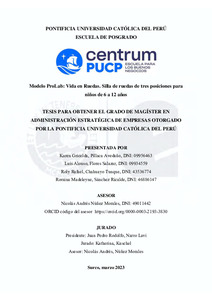| dc.contributor.advisor | Núñez Morales, Nicolás Andrés | |
| dc.contributor.author | Pillaca Avedaño, Karen Gricelda | |
| dc.contributor.author | Flores Salazar, Luis Alonso | |
| dc.contributor.author | Chahuayo Tunque, Roly Rafael | |
| dc.contributor.author | Sánchez Ricalde, Romina Madeleyne | |
| dc.date.accessioned | 2023-07-20T16:36:32Z | |
| dc.date.available | 2023-07-20T16:36:32Z | |
| dc.date.created | 2023 | |
| dc.date.issued | 2023-07-20 | |
| dc.identifier.uri | http://hdl.handle.net/20.500.12404/25409 | |
| dc.description.abstract | El trabajo presentado a continuación surge al determinar un problema social relevante
que aún sigue sin ser solucionado, que es la necesidad de una silla de ruedas especializada de
bajo costo para niños con diagnóstico de parálisis cerebral infantil (PCI) entre 6 y 12 años. La
presente investigación utilizó recursos, de las metodologías, con los cuales se identificaron
las dolencias más críticas del usuario y de su cuidador principal. A través del análisis del
mercado, planteamos una solución que es sostenible y rentable; una silla de ruedas con dos
posiciones adicionales, como son camilla y bipedestador, producto que no se encuentra
disponible en la región de Latinoamérica y cuyos precios y tecnologías no lo hacen
alcanzable para el mercado que elegimos.
Vida en Ruedas está dirigido a un usuario y un cliente, el primero es un niño con
diagnóstico de PCI de 6 a 12 años y el segundo es el padre de familia responsable de su
cuidado. Este modelo de negocio representa una gran oportunidad porque la necesidad de que
el menor tenga una mejor calidad de vida es evidente, también puede aliviar la sobrecarga del
cuidador y esta solución resulta socialmente valiosa ya que responde a los objetivos de la
ODS 3 Salud y bienestar.
Por último, este negocio es también viable financieramente, con flujo de caja
proyectado a cinco años de operación, se obtuvo un VAN esperado de más de S/1,130,000.
Aunque los indicadores de rentabilidad no sean los más atractivos de un mercado de
iniciativas financieras, la principal razón de este proyecto es el beneficio social que se
lograría al implementarlo. | es_ES |
| dc.description.abstract | The work presented below arises from the identification of a relevant social problem
that still remains unsolved, which is the need for a low-cost specialized wheelchair for
children with a cerebral palsy diagnosis (CP) between 6 and 12 years old. The present
research used resources from agile and lean methods, with which the most critical afflictions
of the user and his or her main caregiver were identified. Through the market analysis we
proposed a solution that is sustainable and profitable: a wheelchair with two additional
positions, such as stretcher and standing frame, a product that is not available in the Latin
American region which prices and technologies do not make it achievable for the market we
chose.
Vida en Ruedas is aimed at a user and a customer, the first one is a child diagnosed
with PC between 6 and 12 years old and the second one is the parent responsible for his o her
care. This business model represents a great opportunity because the need for the child to
have a better quality of life is evident, it can also relieve caregiver overload and this solution
is socially valuable as it responds to the objectives of SDG 3 Health and well-being.
Finally, this business is also financially viable, with cash flow projected to five years
of operation, an expected VAN of more than S/1,130,000 was obtained. Although the
profitability indicators are not the most attractive in a market of financial initiatives, the main
reason for this project is the social benefit that would be achieved by implementing it. | es_ES |
| dc.language.iso | spa | es_ES |
| dc.publisher | Pontificia Universidad Católica del Perú | es_ES |
| dc.rights | info:eu-repo/semantics/closedAccess | es_ES |
| dc.subject | Negocios--Planificación | es_ES |
| dc.subject | Niños--Enfermedades | es_ES |
| dc.subject | Parálisis cerebral | es_ES |
| dc.subject | Sillas de ruedas--Innovaciones tecnológicas | es_ES |
| dc.title | Modelo prolab: Vida en Ruedas. Silla de ruedas de tres posiciones para niños de 6 a 12 años | es_ES |
| dc.type | info:eu-repo/semantics/masterThesis | es_ES |
| thesis.degree.name | Maestro en Administración Estratégica de Empresas | es_ES |
| thesis.degree.level | Maestría | es_ES |
| thesis.degree.grantor | Pontificia Universidad Católica del Perú. CENTRUM | es_ES |
| thesis.degree.discipline | Administración Estratégica de Empresas | es_ES |
| renati.advisor.dni | 49011442 | |
| renati.advisor.orcid | https://orcid.org/0000-0003-2193-3830 | es_ES |
| renati.author.dni | 09956463 | |
| renati.author.dni | 09934559 | |
| renati.author.dni | 43536774 | |
| renati.author.dni | 46886147 | |
| renati.discipline | 413307 | es_ES |
| renati.juror | Juan Pedro Rodolfo Narro Lavi | es_ES |
| renati.juror | Katherina Veronica Maria Kuschel Rietzsch | es_ES |
| renati.juror | Nicolás Andrés Núñez Morales | es_ES |
| renati.level | https://purl.org/pe-repo/renati/level#maestro | es_ES |
| renati.type | https://purl.org/pe-repo/renati/type#tesis | es_ES |
| dc.publisher.country | PE | es_ES |
| dc.subject.ocde | https://purl.org/pe-repo/ocde/ford#5.02.04 | es_ES |






